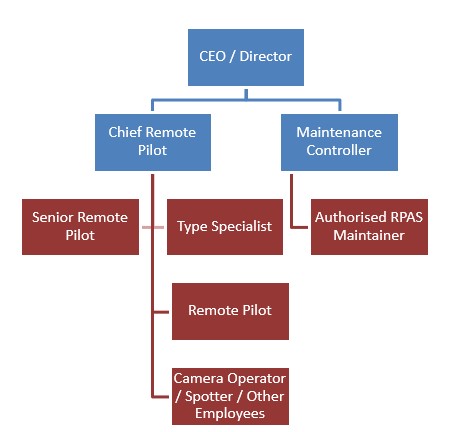The key personnel positions of CEO, Chief Remote Pilot, and Maintenance Controller must be filled by an individual appointed by the operator. CASA must assess and approve the Chief Remote Pilot, and the CEO and Maintenance Controller must be acceptable to CASA.
Operations may not be conducted when a key position is vacant unless approved by CASA.

Organisational diagram.
Key positions and responsibilities
Chief Executive Officer (CEO)
The CEO is responsible for the safety and corporate compliance of RPA operations.
The CEO must ensure:
- the safe conduct of RPAS operations IAW the conditions of the ReOC and the civil aviation legislation
- there are sufficient suitably experienced, qualified, and competent personnel.
- there is a suitable management structure.
- the operation is adequately financed and resourced
- safety performance indicators and targets are set up and regularly reviewed
- the approved documented practices and procedures are checked and managed for continuous improvement
- that key personnel satisfactorily fulfill the responsibilities of their positions IAW this manual and the relevant civil aviation legislation
- CASA is notified of any changes to the:
- operator’s name, address, or contact details
- nominated personnel
- financial status of the operator, which may affect the safety of RPA operations
Chief Remote Pilot (CRP)
The CRP is responsible for safely managing the RPA operations.
The CRP must:
- ensure that RPA operations are conducted IAW the conditions of the ReOC and relevant civil aviation legislation
- ensure that pilots and crew are suitably qualified and have experience and skills to enable them to fulfil the duties of their position satisfactorily
- maintain a record of qualifications held by the RP and OC
- monitor the operational standards and ability of the RP and OC
- review compliance and facilities by:
- conducting internal audits
- reviewing audit findings
- taking any necessary corrective action to rectify deficiencies as soon as possible
- review scheduling and rostering of crew to ensure that fatigue does not adversely affect the safety of operations
- provide the RP and OC with ready access to all documents and manuals necessary to ensure the safety of all flights
- inform the CEO of any matter connected to RPA operations that is relevant to the CEO’s duties
Maintenance Controller (MC)
The MC is responsible for ensuring that RPAS are correctly maintained.
The MC must:
- control all RPAS maintenance, either scheduled or unscheduled
- keep records of all personnel allowed to perform maintenance on RPA, including details of their training and qualifications
- develop, enforce, and monitor RPAS maintenance standards
- maintain a record of RPAS defects and unserviceability issues
- ensure that each item of equipment essential to the operation of each RPA is serviceable before being released to service
- maintain a thorough technical knowledge of each RPAS being used
- ensure that all maintenance activities are conducted IAW the procedures detailed in Section 2 of this manual
- investigate all significant defects in the RPAS
- monitor the failure rates of RPAS components and impose extra maintenance requirements as necessary to ensure the safety of operations
Other positions and responsibilities
Senior Remote Pilot (SRP)
Senior Remote Pilots (SRP) are responsible for operational matters as authorised by the CRP.
SRP are responsible for the following:
- approving standard operations (e.g., excluding those that need an extra CASA, Airservices Australia, or military approval) on behalf of the CRP
- ensuring all RPs are following the correct procedures and checklists for their authorised tasks
- immediately reporting any compliance or safety issues to the CRP
- acting in the role of the CRP when delegated
- abiding by any conditions/restrictions placed on them by the CRP
Type Specialist (TS)
A TS is an RP with a superior Remote Pilot Licence (RePL) rating than the CRP for which the operator intends to operate. The TS will advise the CRP on aspects of flight operations that relate to type specialist requirements.
A TS is responsible for:
- providing advice and guidance to the CRP for specialised type operations
- ensuring specialist operations are planned within type restrictions and countersigning flight authorisations for specified types only
- consulting with MC and providing any technical information for cause analysis, symptomatic problems, etc. related to the specific type
- instructing RPs internally to use the specific RPA type IAW the induction requirements
As this manual requires, all other aspects of flight operations are still governed and overseen by the CRP.
Remote Pilot (RP)
RPs are responsible for the following:
- conducting flight IAW these procedures
- the safe operation of the RPA from the commencement of operations until the RPA is shut down after an operation
- acting IAW the procedures contained in this manual
- acting IAW any conditions imposed on their RePL
- following applicable regulatory requirements and supporting documents, such as the AIP
RP includes a holder of a CASA ‘RePL’ or ‘UAV Controllers Certificate.’
Camera operators, spotters, and other employees
All camera operators, spotters, and other persons involved in the operation of RPAS controlled under the authority of the ReOC must follow the procedures set out in this manual and any lawful direction given to them by a Remote Pilot.
